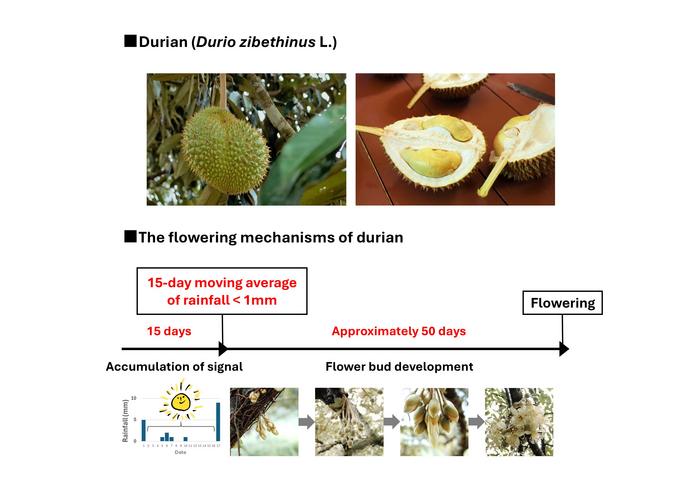In recent groundbreaking research from Tokyo Metropolitan University, scientists have unveiled the fascinating relationship between periods of drought and the flowering cycle of durian plants. The study, spearheaded by Professor Shinya Numata and researcher Aoi Eguchi, provides new insights that could revolutionize agricultural practices for one of Southeast Asia’s most valued crops. The durian, often dubbed the "king of fruits," is celebrated not only for its unique taste but also for its significant economic impact in the region, particularly in Malaysia, where it is the predominant fruit cultivated.
The pivotal discovery stemmed from an elaborate assessment of the flowering behavior of 110 durian plants cultivated in Malaysia. Researchers observed that these plants consistently flower approximately 50 days after undergoing a dry spell lasting about 15 days. This finding is groundbreaking, given that previous research had merely hinted at potential correlations between dry weather and flowering without clearly establishing the specific conditions that trigger this vital stage in the plant’s life cycle.
The significance of these findings extends beyond the durian itself. Understanding how flowering is regulated can enhance not only crop yield and quality but also provide critical insights into the broader dynamics of tropical ecosystems. The study emphasizes that the flowering of durian occurs independently of the plant’s method of propagation—whether grafted or grown from seeds, a fact that simplifies cultivation practices and enhances predictability in agricultural operations.
The observational aspect of the research involved meticulous monitoring of climatic conditions alongside the flowering dates of the durian plants. Researchers used moving averages to accurately analyze rainfall patterns over specified intervals, ultimately determining that an average rain rate of less than 1 millimeter over a 15-day period qualifies as a significant dry spell conducive to flowering. This research sets a new benchmark in the understanding of durian plant biology, leading to questions about other tropical plant species and how they might similarly respond to climatic oscillations.
Interestingly, while the study linked dry weather to flowering, it found no correlation with temperature, either maximum or minimum. This raises intriguing questions about the environmental factors that play a role in flowering, pushing the scientific community to explore the complexities of plant phenology further. It challenges conventional beliefs that temperature fluctuations might primarily dictate flowering times in tropical plants.
The findings also hold relevance for the broader ecological perspectives in tropical regions, which tend to exhibit diverse flowering patterns following dry spells. The researchers proposed that durians may have adapted special mechanisms that allow them to capitalize on shorter dry periods, unlike other species that require extended drought for synchronized flowering events. This adaptability highlights a sophisticated evolutionary strategy, showcasing how certain species can thrive in specific ecological niches while navigating the unpredictability of tropical weather.
Durians typically flower multiple times a year, enhancing their agricultural yield and allowing farmers to optimize harvest periods effectively. These revelations about the durian’s flowering behavior can thus inform targeted agricultural practices, helping farmers better predict flowering and manage their crops. Their eventual goal extends beyond merely increasing the output of this unique fruit; it includes boosting the understanding of the intricate relationships that govern tropical ecosystems and their responses to environmental shifts.
In an age where climate change poses significant threats to agricultural sustainability, this research offers farmers new tools to adapt their practices. With precise knowledge of how weather events—especially dry spells—affect flowering, the potential for tailoring agricultural strategies becomes far more achievable. This could lead to enhanced food production while also minimizing the competition and stress on resources that can accompany agricultural fluctuations.
Supported by a grant from Japan’s JSPS KAKENHI, the study lays a sound foundation for future investigations. The research team hopes to expand their inquiries to include a wider range of ecological interactions and flowering mechanisms that may not yet be understood for other economically significant tropical crops. By examining the full spectrum of environmental variables and plant behaviors, they can contribute to the ongoing efforts to safeguard the food supply in the face of unpredictable climate changes.
In conclusion, the work undertaken by Tokyo Metropolitan University’s researchers is not only an exemplary model of interdisciplinary science bridging agriculture and ecology but also a call to action for further study. By delving deeper into how flowering is influenced by climate, scientists can provide essential insights that will not only enhance the cultivation of durian but also offer broader solutions applicable to many crops facing similar environmental pressures. This will undoubtedly prompt more inquiries in the field, potentially leading to innovative agricultural practices that are more resilient to changing climate scenarios.
Furthermore, it underscores the critical need for integrating scientific research into practical applications within farming communities. As more studies like this emerge, they pave the way for enhanced agricultural productivity and sustainability, ensuring that valuable crops like durians continue to flourish even as they navigate the challenges posed by a rapidly changing environment.
Subject of Research: The impact of dry spells on the flowering of durian plants
Article Title: Dry spells trigger durian flowering in aseasonal tropics
News Publication Date: 12-Nov-2024
Web References: DOI link
References: International Journal of Biometeorology
Image Credits: Credit: Tokyo Metropolitan University
Keywords: Durian, flowering, drought, agriculture, tropical ecosystems, phenology, climate change, horticulture, ecological dynamics, crop production, Southeast Asia, plant biology.




